Somewhat contradictorily given my frequent declaration of my love of multiple shirt sponsors, I can’t help but think international shirts are beginning to look a bit crowded these days. I guess its due to the fact that they have never been sponsored at senior level and over the years have provided a more minimalist, cleaner alternative to the logo emblazoned shirts of domestic clubs.
First names appeared on the back of the shirts, numbers have appeared on the front of the shirts (around 1992 if memory serves) and sleeve patches promoting the relevant tournament and/or FIFA or UEFA’s latest scheme have all been added to make the shirts seem much busier than they used to be. The last 10 years or so has also seen the rise of specific matchday embroidery on most (but not all) international shirts (I must make clear at this point that this term is a tad misleading as, no doubt driven by cost, the individual match details international shirts are no longer embroidered but are in fact heat applied – thanks Shakey).
Of course in the old days additional embroidery only featured on an international jersey if the side reached a major tournament, and then the same design was used for every match that was played. Years later this transformed into match specific details much to the delight of the match worn shirt collector who could now tell at a glance exactly what game a top was worn in.
Looking at the recent matches involving the UK’s home nations (and also the Republic of Ireland) I thought it might be interesting to see how each side commemorated their games as curiously there are no uniform FIFA/UEFA directives that say how the matchday embroidery (lets stick with that term, its easier) should look. Surely though it is only a matter of time before this is brought in.
Please note I’ve tried to match typefaces as closely as I can below but the graphics are really designed to just give a general representation of how the matchday details look…
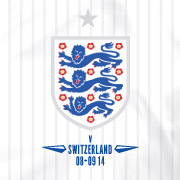
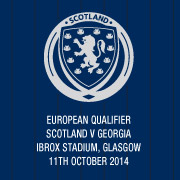
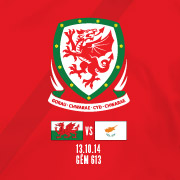
England opt for a simple but logical message, with their opponents featured below a ‘v’ with the date in numerals below that. What does give this basic information a bit of flair are the heraldic, geometric flourishes on either side of their opponents name. Perhaps superfluous, I must confess they do give the details some gravitas. Scotland’s shirts are by far the wordiest of the home nations with a virtual essay appearing beneath the SFA badge. Firstly, the tournament appears followed by both teams, the venue and finally the date, written out in full. It does seem a bit excessive in my view and adds to the clutter of the shirt. Two lines would have looked a lot neater in my opinion. Wales go for the tried and tested (and very popular) flag route. Graphically interesting but perhaps confusing if you don’t know your flags. Be honest, any idea what country is featured in the example above*? What’s particularly interesting about the Welsh embroidery is the addition of the Welsh word ‘Gem’ beneath the numerical date. Gem translates simply as ‘game’ or ‘fixture’ and is followed by the appropriate match number providing a neat, though perhaps unnecessary on a football shirt, record of Welsh football fixture history.
Northern Ireland also take the flag route for their matchday embroidery. They keep it simple though with not even a ‘V’ or ‘VS’ between them. Instead an abbreviated date is simply placed beneath the flags. The Republic of Ireland have gone through a few changes with their matchday shirts in recent games, proving that the style of commemorating a game on a shirt graphically is very much a moveable feast and apparently determined by the individual football association rather than manufacturer. Recent matches had seen the Irish acknowledge their opponents with an ornate scroll beneath the badge. By the European Championship qualifiers against Georgia and Germany in October 2014 flags were introduced along with the date in full beneath them. However during the game against Scotland last night (14 November) this was altered again with the date reduced to numerals and the venue also added beneath.
I’m not sure how much detail is necessary with matchday embroidery, and part of me thinks the shirts would look better without it, after all its barely legible unless you actually have the shirt in your hand. Perhaps this individual match embroidery replaces the traditional ‘cap’ with players now given a match specific memento of their international performance in the form of a shirt. Perhaps someone could confirm this? Either way – its clear the embroidery is here to stay.
*It’s Cyprus!

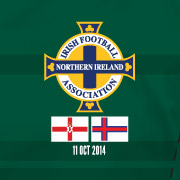
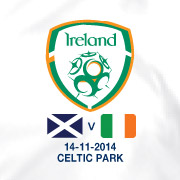
John, the 3 England, Scotland and Wales all used to carry match details on their shirts at various times during the 1950’s.
Scotland on their old Rampart Lion Shield had basic SvE as an example, England had a scroll underneath the 3 lions crest and Wales had various ways of displaying opponents but settled on a scroll above the Heraldic crest that was introduced in 1951. Wales actually continued to carry match detail scroll up until 1974.
They are individual mementoes for players of specific games but that only applies if the player in question either keeps or collects his shirts!! In the ’50’s the likes of Tom Finney, Duncan Edwards & Ivor Allchurch as examples, would remove the crests off their shirts and give away or bin the actual shirt.
Personally as a match worn shirt collector i really like the use of match detail info on players shirts.
Regarding international caps, i believe Scotland are now discontinuing the presentation of a cap, instead are now giving players match pennants with all the details they put on the shirts embroidered on. England of course are the only nation to provide more regular caps, not quite one per game, but one per friendly, then one per qualifying campaign -with the countries the player has played against embroidery onto the panels on the cap- and one per finals tournament. Northern Ireland and Wales continue to present players with one cap per season, whether the player has played one or ten games during that season.
I was very happy to see the re-introduction of match embroidery details by Umbro for England in 2009, though I was disappointed when it became a heat transfer the following year – it’s also a shame that Nike haven’t continued the same scroll design.
Jon, you’re right about international shirts becoming too crowded – this isn’t helped by all the tournament FIFA/UEFA force teams to wear even just for qualifiers!
I can’t justify why, but vs irritates me when v will do. Also the Euro qualifiers sleeve patches with the clipart shirt in a heart are absolutely dreadful, has UEFAs graphic design budget run dry?
one thing about match day embroidery and caps that bugs me so much is the lack of a standardised system for the issue of said cap or the use of stars above a club badge,
before anyone says anything let me explain, i know it seems like a trivial thing and probably not worth the effort to change, especially across every nation in the world, and im not a dictator that wants everyone to conform to ISO standard, hell it makes it an interesting topic to discuss (wouldn’t mind seeing an article …..its such a great topic and its been in football for years)
but it can be kind of confusing at times, i mean the bundesliga dosnt recognise titles pre bundesliga, and some leagues have have 1 star symbolising anything from 1 league title to anything between 3, 5, 10 or sometimes even 20 titles (or something along those lines im not sure of the details but the leagues that have one star for 3 are puzzling cos they have it as well as the 5)
currently the only system that’s easy to understand is that of FIFA (and kudos to them for disallowing Uruguay counting its two Olympic wins – i was getting jealous that England couldn’t have 3 stars to symbolise our two – they sure put down that can of worms)
i would like to see this system in use in England but only if its done right, currently the only team that has stars is Manchester City and they don’t mean anything (though they are quickly doing a good job rectifying it with two premier league titles as of this post)
i don’t think we EVER will adopt this though because their would be the whole debate as to who can display them (yeah im looking at you Liverpool – your division one title haul in the 70s/80s was impressive and its a shame to leave it out because my team Sheffield Wednesday could also display the 4 we won at the turn of the century but i think we should only count Premier League wins for simplicity’s sake)
as for caps, caps i just never did understand fully despite my granddad explaining it to me when i was younger lol